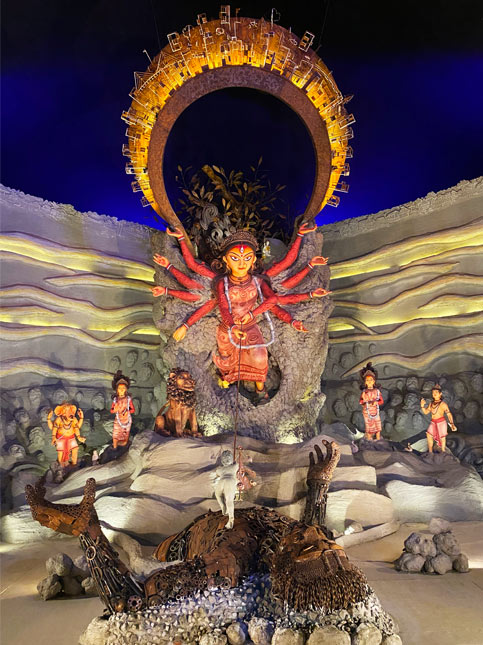Ideas
- Category Name
- Ideas
Want a personalized
Speak to our design professionals
Share your info, we’ll book your slot.
Will you be living in your space during the renovation?
 Previous Question
Previous Question
 Previous Question
Previous Question
Please Select Date and Day
Appointment Date & time

While the festival has always been an artistic celebration, artists now have the freedom to experiment with materials, forms and narratives that go beyond traditional iconography. Kolkata-based interior designer Pooja Bihani takes us to some of these fabulous art installations
The frenzy, the crowds, the colour and the controlled chaos. It all crescendos to the currents of excitement that are palpable in the very air of Kolkata during Durga Puja. However, the festival that is one of this city's most defining features is more than its outpouring of devotion. It is a sublime expression of creativity—art, design and innovation get mainstreamed for public consumption and admiration. “Initially, pandals focused more on traditional aesthetics and religious symbolism. In recent years, there has been a shift towards thematic storytelling. Today, artists incorporate contemporary social issues or environmental concerns, and do so with innovative use of materials,” says interior designer Pooja Bihani.
The founder of Kolkata-based design studio Spaces and Design has been visiting pandals around the city for some years now. In fact, this annual pilgrimage holds special significance for Bihani. “I’m fascinated by how spaces can tell stories, and visiting pandals allows me to explore this passion.” Her studio creates environments that blend art, culture and sustainability, and hinges on harmonising function with aesthetics. The pandals then offer a fascinating glimpse into just how creative such public spaces can be. In her stroll through the city streets, she found some stand-out installations.
“This year, they are as good as immersive art installations. They engage and educate the public while celebrating the festival. In recent years, local architects and artists have also gotten involved,” explains Bihani. Durga Puja also happens to be, according to NGO massArt, “the world’s largest publicly funded art show”. Set up in 2022 to promote art and culture in Bengal, the non-profit works to showcase and promote art and culture in Bengal. Clearly, it’s working. The pandals have turned into artistic installations that are as much of a draw as the goddess Herself. It also bears a UNESCO-recognised tag, apart from street cred if the crowds are anything to go by. “Each pandal had a distinct personality, and the artists’ ability to convey deep stories through materials and space was remarkable,” she says.
The Bosepukur Sitala Mandir made dramatic use of earthen pots, for instance. The makers leveraged the symbol and the material to convey the idea of sanchoy, or “savings”. It is based on the concept of the lakhi bhandar, the Bengali word that loosely translates to a traditional cash box typically made of earthenware. In South Kolkata, the Rajdanga Naba Udayan Sangha’s pandal pivoted to a contemporary preoccupation—technology and its ubiquity. “It explored the balance between technological development and nature,” elaborates Bihani. At this year’s pandals, she also observed this mindful use of materials. “Intricate installations were crafted out of reclaimed wood, rusted steel, and GI sheets.”
Materiality, messaging and storytelling all came together in remarkable, unexpected ways this year. As Bihani says, “While the festival has always been an artistic celebration, the scale and thematic diversity are relatively recent developments. Artists now have the freedom to experiment with materials, forms and narratives that go beyond traditional iconography.” Intrinsic to that is the freedom to interpret the goddess, whether it is in her more traditional avatar or in an abstract form. The pandal of the Kendua Shanti Sangha chose a high-minded, metaphysical route. “The artist used tin sheets and nylon threads to create a dynamic environment that resonated with sound waves to portray divine realisation.”
At the other end of the spectrum was the pandal by the Naktala Udayan Sangha. It was grounded entirely in material, physical life and the concept of family. The focus was on food and the act of cooking and eating bringing families together. Steeped in the nostalgia of a fast-disappearing joint family system, this “was a poignant reflection on the changing dynamics of urban families”.
Diverse and meaningful, thoughtful and evocative, these pandals offer an opportunity to introspect as much as an avenue to celebrate. And what better medium than art to nudge the faithful—perhaps even the cynical—on a path towards a better understanding of the world they inhabit?
All images by Praveen Kanodia
Will you be living in your space during the renovation ?
DEC 2023
Please Select Date and Day
Appointment Date & time
17 Oct 23, 03.00PM - 04.00PM










